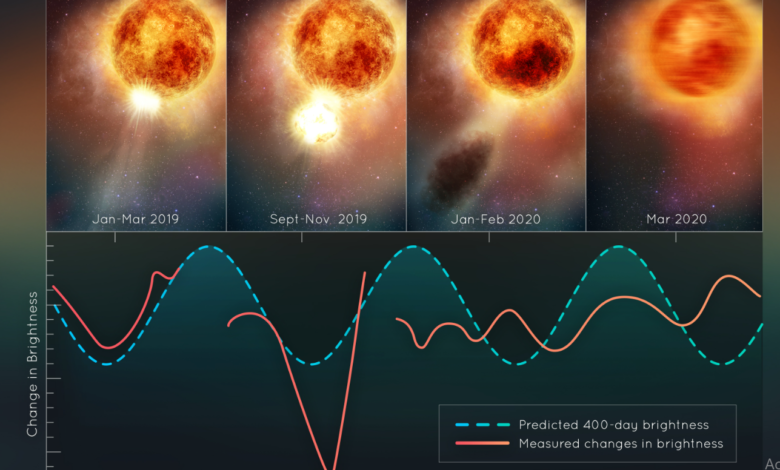Betelgeuse is bouncing back after blowing its top in 2019

Coronal Mass Ejections occur frequently when the sun expels chunks of its outer temper, the corona.
Data from the Hubble Space Telescope and other observatories led scientists to the conclusion that the bright red supergiant star Betelgeuse "blew its top" in 2019, shedding a meaning corporeality of its visible surface and releasing a massive Surface Mass Ejection (SME). To my knowledge, this has never happened earlier with a typical star.
Coronal Mass Ejections occur ofttimes when the lord's day expels chunks of its outer temper, the corona. While most CMEs are quite small in comparison, the one from Betelgeuse ejected 400 billion times as much mass.
Monster star is withal getting back to normal subsequently the devastating disruption."Betelgeuse continues doing some very unusual things right at present; the interior is sort of billowy," said Andrea Dupree of the Centre for Astrophysics | Harvard & Smithsonian.
The new data shed light on the process by which reddish stars shed mass when their nuclear fusion furnaces run out and eventually explode as supernovae. Their eventual destiny is very dependent to the caste of mass loss. Betelgeuse'south unusually spoiled behaviour is not, yet, a sign that the star is poised to go supernova in the near future. That mass loss upshot may non be a precursor to an explosion.
Dupree is now piecing together the star's petulant conduct before, during, and during the eruption into a cohesive account of a never-earlier-seen gigantic earthquake in an sometime star.
The STELLA robotic observatory, the Tillinghast Reflector Echelle Spectrograph (TRES) at the Fred 50. Whipple Observatory, NASA's Solar Terrestrial Relations Observatory (STEREO-A) spacecraft, NASA'southward Hubble Space Telescope, and the American Association of Variable Star Observers have all contributed new spectroscopic and imaging information (AAVSO). To Dupree's point, the Hubble data was crucial in unravelling the enigma.
"We've never before seen a huge mass ejection of the surface of a star," she said. "We are left with something going on that nosotros don't completely understand. It'due south a totally new miracle that nosotros can observe straight and resolve surface details with Hubble. We're watching stellar evolution in real time."
The 2019 titanic outburst may have been triggered by a massive convective plume, with a diameter of over a million miles, rising from the star'south interior. The cooling component of the photosphere acquired shocks and pulsations, which blew off the chunk of the photosphere, leaving the star with a massive common cold surface area beneath the dust deject. The injury has hampered Betelgeuse's recovery efforts.
A fragment of the photosphere, weighing many times as much as our moon, flew out into infinite, where it cooled to create a grit deject that obscured the star from Earth. Fifty-fifty from a backyard, the fading that started in tardily 2019 and lasted for a few months was immediately apparent. Betelgeuse is ane of the brightest stars in the sky and may be seen in the correct shoulder of the constellation Orion.
What's more incredible is that the supergiant'southward previously observed 400-day pulsation rate seems to have stopped, at least temporarily. For over two centuries, astronomers have tracked this pattern in the brightening and shifting of Betelgeuse's surface. The severity of the explosion is shown by the havoc information technology causes.
In order to explain the star's regular pulsating, Dupree proposes that the star's internal convection cells are sloshing nearly like an unbalanced washing machine tub. According to TRES and Hubble spectra, the photosphere may be repairing itself, simply the surface is yet bouncing like a dish of gelatin cake.
Small chunks of the Sun'south outer temper are blown off during coronal mass ejections, but scientists take never seen such a big portion of a star's visible surface blasted into space. As a upshot, it'due south possible that coronal mass ejections and surface mass ejections are 2 separate phenomena.
If Betelgeuse were to accept the place of the sun as the solar system'due south primary star, its outer surface would now reach beyond Jupiter's orbit. It wasn't until 1996 that Dupree was able to apply Hubble to make out hot patches on the star's surface. For the showtime fourth dimension, a star other than the sun was captured in its entirety on film.
The James Webb Space Telescope, a NASA telescope, may exist able to detect the ejected droppings in infrared light as it continues to move away from the star.
This story has not been edited by News Mania staff and is published from a syndicated feed
Photo: Internet
Source: https://www.newsmania.co.in/2022/08/13/nasas-hubble-space-telescope-sees-red-supergiant-star-betelgeuse-slowly-recovering-after-blowing-its-top/
Posted by: blankenshiphoure1985.blogspot.com

0 Response to "Betelgeuse is bouncing back after blowing its top in 2019"
Post a Comment